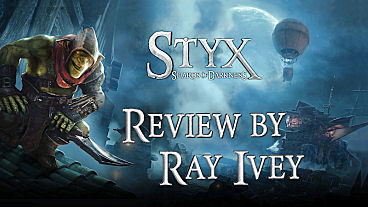
Styx: Shards of Darkness Review
Overall, Styx: Shards of Darkness is a very solid steath adventure that’s easy to recommend
Genre: Stealth Action Adventure
Release date: March 14, 2017
Platforms: Windows, PS4, Xbox One (reviewed on PS4)
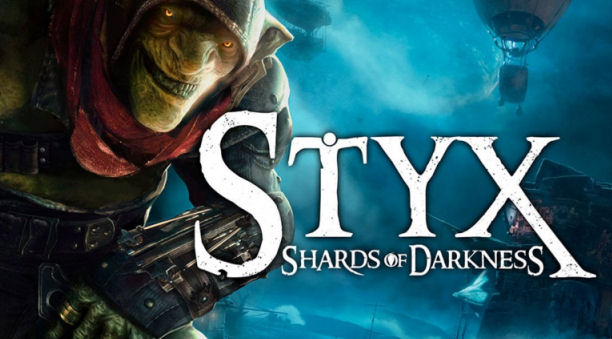
I’m a huge fan of stealth games, or even games that include stealth, so I figured Styx: Shards of Darkness would be right up my alley.
Disclaimer: I did not play the earlier game, Styx: Master of Shadows, or Of Orcs and Men, the 2012 game that established this game world. But this lack of experience did not keep me from enjoying the grim but colorful world of Styx.
Styx lives in a world populated by Humans, Dwarves, Trolls and Elves. Goblins seem to be a hated minority and are frequently killed on sight.1 Styx, a wily, profane and talented goblin thief, must venture out of the safety of his hideout to investigate a new and troubling alliance between the elves and the dwarves.
At the core of Styx: Shards of Darkness is very solid stealth gameplay. Perspective is over-the shoulder third person. Styx can crouch in the shadows, move almost silently, and generally get around undetected…if he’s careful. As in most stealth games, confrontation and combat are always a last resort. Playing a game like this and concentrating on the fighting aspect of the game would be a mistake. And so I didn’t. In fact, every time I was detected, I simply reloaded. Judge me if you must.
So: your main challenge in each of the expansive levels of the game is to traverse the environment, accomplish your objectives, and get out without being detected. When you complete a mission, you get points that you can spend to upgrade your abilities in a variety of areas: alchemy, stealth, combat, perception, and managing your magical clone. While these various skill trees do give you the feeling that you are creating a customized character that’s all your own, I must report that by the end of the game I had maxed out pretty much every skill tree, making my earlier choices feel less important..
The first impression I got from the game was how good it looked and how well-designed the levels are. It was super fun to slink around the human village in the prologue mission. I really like verticality in level design, and this game has it in spades. If I was having trouble getting where I wanted to go, chances were good that I could look down or up to find a solution. This means there’s a lot of platforming in the game, which is also a gameplay element I almost always like.2 .
I also respond well to choices in gaming, and Styx: Shards of Darkness provides lots and lots of choice. Do I sneak up behind the guard and silently gut him like a trout, or do I sneak past him? Do I shoot the guard with my lethal darts? Or poison their food or grog? Or maybe I drop a really heavy chandelier on them?
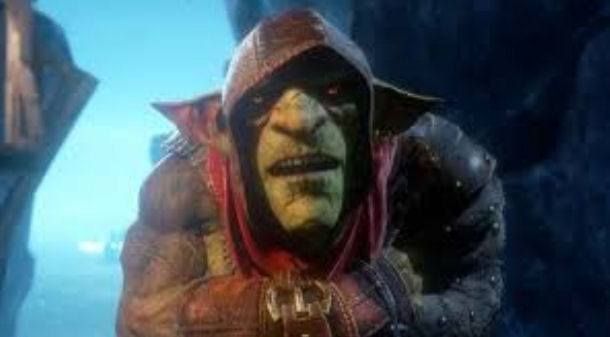
Surprisingly, there’s one traditional element of sneaker games that’s missing from Styx: the non-lethal knock-out. Styx is a little guy, and I guess the thinking is that he’s not burly enough to knock out a human guard twice his size. Since I generally use a no-kill playstyle for stealth games, this game gave me pause. It was a choice I was surprised to not have in a stealth game. But I got over it in about two minutes when I realized that everyone in this freakin’ town considers goblins vermin, and kill or imprison them on sight. My style then comfortably shifted towards lethality. I became an expert at sneaking up behind an unsuspecting human or elf, and killing him real bad. Or vomiting into their communal water jug, thereby poisoning them the next time they took a sip. Or pushing barrels of vicious acid onto them from above.
The most hilarious way to end your foes in this game has to do with chandeliers. There are more chandeliers in the world of Styx than pedophiles at a Papal Conclave. And they’re all incredibly heavy, and the dopey guards just loved to stand underneath them. And they all have a convenient quick release lever which, when flicked, drops a ton of gobliny revenge on the unsuspecting dopes underneath.
But It’s one of the pleasures of being a gamer that you can live with such a ridiculous design element: heavy hanging objects with quick release buttons. You know. Just like in real life.
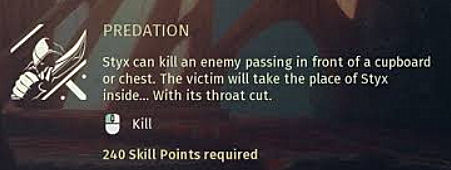
There are four levels of difficulty in the game. First there’s Discovery, which makes combat easy and stealth almost unnecessary. Why pick up a game like Styx and play that way? Second level is Initiated: combat still pretty easy, stealth still a bit augmented. I played it on the third level, Goblin: Styx can’t do direct combat at all, and;a single blow kills him. The fourth level of difficulty –- Master — disallows interior saves during missions (though there are some auto save points). Considering how huge the missions are in the game, I decided I wasn’t interested in that kind of heartbreak.
However, even on this third level of difficulty, the game wasn’t difficult. I’ve actually been stunned at comments I’ve read online about the stealth in the game being “unforgiving.” Perhaps so…but it’s a stealth game, so make sure you’re not seen, dude. Perhaps the game feels easy because I’m such a veteran at stealth games.
One of my biggest complaints about any game, whether it’s a board game or a video game, is flatness – meaning gameplay doesn’t change or evolve from the first part of the game to the last. At first, I was afraid Styx would be guilty of this: that I’d see the same human or elf enemies, sneak up behind them, kill them real bad, stash their bodies so other guards won’t become alarmed, rinse and repeat.
Happily, though, my fears proved groundless, as they so often do. Soon, there were armored enemies I had to contend with. These burly types couldn’t be stealth-killed from the back. What’s more, if I somehow did manage to kill them (poison, dropping a chandelier, etc.), they were too heavy for me to pick up to hide the bodies. Also arriving, as I got deeper into the game, were sheep-sized bugs that are tricky to kill or avoid. Then flying creatures who liked to spit fatal acid at me. And huge cave trolls. And, worst of all, dwarves who could smell me when they got close.
It took canny use of my evolving set of special powers and abilities to deal with these ratched-up challenges. I learned how to kill heavily armored enemies by hiding in a wardrobe or chest and ambushing them as they walked by. I learned to make acid traps I could place carefully, which would literally dissolve most foes (except those stupid trolls.) who walked over them. I learned to make a potion to make my goblin stench temporarily undectable by those hated dwarves. And so on.
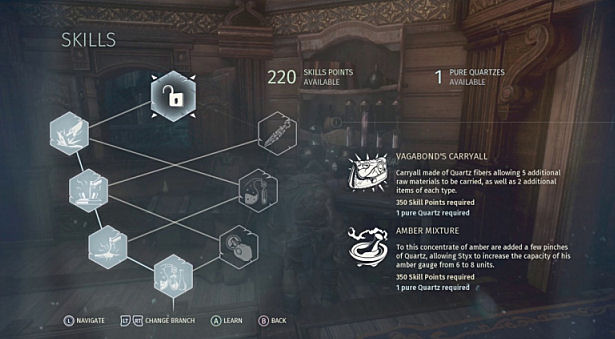
The levels would also contain optional objectives that I could pursue for extra fun and extra skill points. Many of these were fun, but I was swimming in so many skill points, they were rarely necessary. One of the most fun optional objectives are collections of twenty tokens scattered all over each mission, many in very difficult places to reach. The only problem with this optional goal is that the skill-point rewards for getting all twenty seem very paltry considering the effort it takes to track them all down and nab them.
One of the challenges any stealth game has to face is, “How do you design boss battles in a game in which the player character is designed for non-confrontation rather than combat?” Styx: Shards of Darkness has two major boss battles, and in both instances it fulfills this challenge nicely. My only problem was with the first of the two boss battles, which is very long, has no save points in it, and includes a sly little bit after the monster that kept killing me was dead. Every time this happened I had to do the entire long boss battle again. It got pretty frustrating until I figured out the trick. The final boss battle is even longer, but has several auto-save points so it doesn’t get frustrating if you are having trouble.
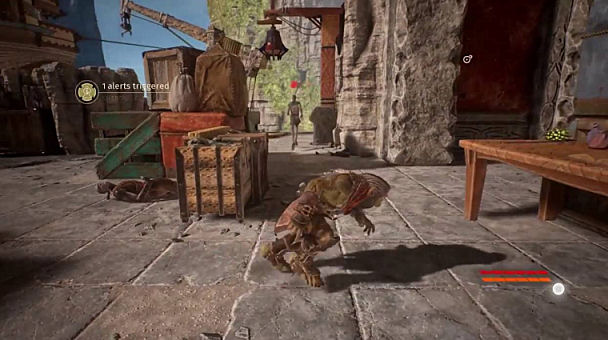
The game doesn’t have much fun with Styx’s equipment. I found one dagger and two costumes I could switch out, and in a game this beefy that seems kind of meagre. It also has awful rope-climbing and swinging mechanics.
The voice acting in the game is a very mixed bag. Styx himself is very well voiced by Saul Jephcott. Styx talks to himself a lot, and frequently breaks the fourth wall and addresses the player directly (especially when he dies; it’s pretty funny). The other leads are pretty good, but the performers doing the rank-and-file guards, soldiers, acolytes, etc. are just okay. You hear Styx the most, though, and Jephcott carries the show with style and impact.
I must also give props to the lovely and effective musical score by Henri-Pierre Pellegrin.
Overall, Styx: Shards of Darkness is a very solid steath adventure that’s easy to recommend.
__________________________________________________________________________
1No Orcs in sight, though. I wonder what happened to them?
2As has been well established, while I truly suck at 2D platformers, when it comes to 3D platforming, I have the grace of an olympic figure skater.
|
+ Great, expansive level design
+ Some good voice acting
+ Very solid stealth gameplay
– It’s a shame you can’t knock foes out
– Lousy rope-climbing controls
|
 |
Memory: 8 GB RAM
Graphics: 1 GB, AMD Radeon R7 260X / NVIDIA GeForce GTX 560

Leave a Reply